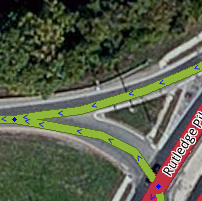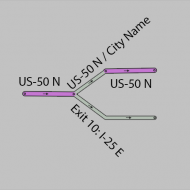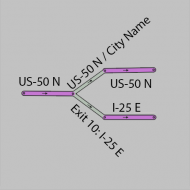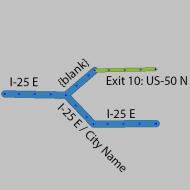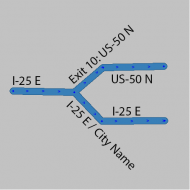(→Wayfinders: Added images) |
(→Wayfinders: finished additions) |
||
| Línea 113: | Línea 113: | ||
{{NeedImage| Need sample images for "lane drops" and "non-obvious continuations"; also, example of BGS with lane arrows}} | {{NeedImage| Need sample images for "lane drops" and "non-obvious continuations"; also, example of BGS with lane arrows}} | ||
<!--[[File:FreewayS-inS-out.png|200px|left]]--> | |||
In these cases, we need to use a wayfinder configuration. Each wayfinder configuration will have one "IN" segment and two "OUT" segments. | In these cases, we need to use a wayfinder configuration. Each wayfinder configuration will have one "IN" segment and two "OUT" segments. | ||
| Línea 134: | Línea 135: | ||
<div style="font-size:smaller"> | <div style="font-size:smaller"> | ||
{| class="wikitable" | {| class="wikitable" style="text-align:center" | ||
|- | |- | ||
! Exit direction | ! Exit direction | ||
| Línea 144: | Línea 145: | ||
| Right | | Right | ||
| Basic exit | | Basic exit | ||
| | | '''Continuation side'''<br/>{{Ramp|Named Ramp stub}} → {{Freeway|Named Fwy}} | ||
| | | '''Exit side'''<br/>{{Ramp|Named Ramp}} | ||
| [[File:RightExitRamp.png| | | [[File:RightExitRamp.png|190px]] | ||
|- | |- | ||
| Right | | Right | ||
| Fwy split | | Fwy split | ||
| | | '''Continuation side'''<br/>{{Ramp|Named Ramp stub}} → {{Freeway|Named Fwy}} | ||
| | | '''Exit side'''<br/>{{Ramp|Named Ramp stub}} → {{Freeway|Named Fwy}} | ||
| [[File:RightExitSplit.png| | | [[File:RightExitSplit.png|190px]] | ||
|- | |- | ||
| Left | | Left | ||
| Basic exit | | Basic exit | ||
| | | '''Exit side'''<br/>{{Freeway|Unnamed Fwy stub}} → {{Ramp|Named Ramp}} | ||
| | | '''Continuation side'''<br/>{{Freeway|Named Fwy stub}} → {{Freeway|Named Fwy}} | ||
| [[File:LeftExitRamp.png| | | [[File:LeftExitRamp.png|190px]] | ||
|- | |- | ||
| Left | | Left | ||
| Fwy split | | Fwy split | ||
| | | '''Exit side'''<br/>{{Freeway|Named Fwy stub}} → {{Freeway|Named Fwy}} | ||
| | | '''Continuation side'''<br/>{{Freeway|Named Fwy stub}} → {{Freeway|Named Fwy}} | ||
| [[File:LeftExitSplit.png| | | [[File:LeftExitSplit.png|190px]] | ||
|} | |} | ||
</div> | </div> | ||
Revisión del 18:39 23 jun 2014
| This revision of a section is currently undergoing modifications. The information presented should be considered a draft, not yet ready for use. Content is being prepared by one or more users. Do not make any changes before you send a private message to this user. Please use the talk page for thoughts and ideas on setting up this content. |
An interchange is a road junction where two roads are connected by dedicated roadways, called ramps. The roads connected by an interchange do not intersect one another directly, and if they cross, the crossing is grade-separated.
Since interchanges often involve grade-separated crossings, the road elevation of the segments becomes important. If two roads cross without connecting directly, their elevations must be different.
This article is a sub-article of the Junction Style Guide. As such, this article is a Style Guide as well. The following sections discuss the proper style for ramps, interchanges, and some common Interchange designs. Note that some interchanges may be a hybrid of these basic designs where one side or quadrant of the interchange may differ from the others.
Before reading through this article, be sure to fully understand the information in the Junction Style Guide.
Ramps
Ramps have a very specific purpose in Waze. They are intended to connect segments of Minor Highways, Major Highways, and Freeways to roads where there are no at-grade crossings.
The Ramp type is used extensively in interchanges for three reasons.
- Ramp segment names are not displayed on the map. This
- Ramp segments have essentially no penalty, so they can be used to connect Freeways and Major Highways with each other without causing problems.
- Ramp segments are relatively small but show at high zoom levels, so interchanges do not distract from highways but can be seen at high speeds.
When to use ramps
Use of the Ramp type is governed by the following rules:
Ramp geometry and complexity
When placing the beginning of a ramp, place the first geometry node of the ramp segment at the point where the solid white line begins, and extend the ramp naturally to create a junction with the road segment, typically at a 10–15° angle. This will allow for consistent timing of exit instructions.
Do the same when placing the end of a ramp. This will allow for consistent auto-zoom functionality—the client remains zoomed in for the duration of the ramp, zooming out when the user gets on the freeway.
Rule #1 is still simpler is better. If there is no large distance between paths at the end of a ramp (either into or out of the ramp), a single segment connecting to a single junction node is all that is needed. The existence of a painted, concrete, or grass island is NOT enough of a reason to split a ramp into multiple ramps.
When paths at the end of the ramp deviate significantly in distance, regardless of the existence of any type of island, then multiple ramps should be used.
Interchange types
These are junctions involving the three Highway/Freeway road types - Minor Highway , Major Highway , and Freeway -- as well as their Ramps .
Specific examples of how to handle common junction types are provided in later sections. All of those examples use the basic building blocks provided here.
If you are unsure what road type you should use, refer to the following pages for more information.
Exits
It is a basic Exit situation when a "straight" direction is obvious to a driver and navigation instructions are only needed for the non-straight direction (the exit.) If navigation instructions are required for both directions, see the Wayfinder Segments section below.
Exit geometry
To be treated as a basic Exit, the following must be true:
- The entering segment and one exiting segment must be one of the three Highway/Freeway types
- The Highway/Freeway exiting segment must have close to a zero degree departure angle from the entering segment
- The other exiting segment must be of the type Ramp
- The Ramp exiting segment must have a departure angle of between 20 and 30 degrees from the entering segment
When those conditions are met, the navigation will present an "Exit Right/Left" instruction when the ramp is to be used, and will remain silent when the exiting Highway/Freeway segment is to be used.
Exit naming
The Highway/Freeway segments before and after the junction should be named the same. The ramp segments should be named in accordance with the best practices in your location.
Naming standards for other areas
Editors covering areas that do not have specific best practices should review the existing guides for other areas, and determine which best matches the roadways of your area.
Freeway/highway splits
A Highway/Freeway Split is when a Highway/Freeway segment meets at a junction with two other Highway/Freeway segments and there is no obvious straight through direction to a driver.
Freeway split geometry
To receive a navigation instruction for both branches of a split, the following must be true:
- All segments must be one of the three Highway/Freeway Types
- All segments must have names which are different from each other
- The two exiting segments must have departure angles of 20 to 30 degrees from the entering segment
With those conditions met, the junction will present "Keep Left" and "Keep Right" navigation instructions using the name of the appropriate exiting segment.
Freeway split naming
The primary rule is that all 3 segments at the junction must have different names. That can be accomplished in one of two ways:
- Using road names alone - It is an easy situation if all three roads which connect have different names. If "Highway A" splits into "Highway B" and "Highway C", then that is all we need to have a properly functioning split.
- Using signs and Wayfinder Segments - If one of the branches of the split has the same name as the entering segment, we must create uniqueness at the junction. If "Highway X" splits off from "Highway Y" and "Highway X" continues as the other branch, the preferred approach is to use named Wayfinder Segments.
Wayfinders
A wayfinder gives a user an instruction reminding them to stay on the road the user is already on, in situations where a reminder is warranted. A wayfinder is warranted in the following situations:
- Lane drops, where at least as many lanes leave the road as stay on the road;
- Non-obvious continuations, where at least one "exit only" lane exists on the side of the road where exits are not normally placed (in a right-hand traffic country, exiting traffic is to the left and continuing traffic is to the right); and
- Inconsistent signage, where a highway continues as a numbered route, but signs call it only by a name.
| Need sample images for "lane drops" and "non-obvious continuations"; also, example of BGS with lane arrows |
In these cases, we need to use a wayfinder configuration. Each wayfinder configuration will have one "IN" segment and two "OUT" segments.
Keep these basic principles in mind:
- The OUT segments must be the same type (either Freeway or Ramp, as explained below).
- Each OUT segment must have a name different than the IN segment.
- OUT segments should be named with the information displayed on the roadway signs.
- However, if this would leave an OUT segment with the same name as the IN segment, the OUT segment name must be modified.
- Do not use "to" at the beginning of the name of the continuation segment (the user is already on the road, not going "to" it).
- Each "stub" segment should be Segment length/Minimum long. This is long enough so it will not cause routing problems, but it is short enough to suppress names (on Freeway stubs) and keep freeways looking contiguous (on Ramp stubs).
To configure the wayfinder,
- If the numbered/signed exit is on the right, the OUT segments should be Ramp type. This will give an "exit right" instruction for the exit and a "stay to the left" instruction for the continuation.
- For a basic exit, use a named Ramp stub for the continuation, and a standard Ramp for the exit.
- For a freeway split, use a Ramp stub on both sides.
- If the numbered/signed exit is on the left, the OUT segments should be Freeway type. This will give "stay to the" instructions on both sides (if Ramp segments were used, Waze would give a confusing "exit right" instruction for the continuation).
- For a basic exit, use a named Freeway stub for the continuation, and an unnamed Freeway stub followed by a named Ramp for the exit.
- For a freeway split, use named Freeway stubs on both sides.
Ramp-ramp splits
A ramp may itself split and branch into two directions. If this is the case, "Exit Right" and "Exit Left" will be announced using the name of the appropriate exiting segment in all cases.
Ramp split geometry
Ramp split naming
If ramps are unnamed, the name of a subsequent ramp will propagate backwards. In the example above, if the two ramps exiting the junction are named, the ramp entering the junction can be left unnamed. Then any navigation instruction directing you onto the first ramp would use the name of the appropriate exiting ramp.
Example: The two ramps exiting the junction are named "DestinationLeft" and "DestinationRight". The ramp that enters the junction is unnamed. If you need to "Exit Right" onto the unnamed ramp. If you are headed to "DestinationLeft", navigation would tell you:
- Exit Right to Destination Left
- Exit Left to Destination Left
Using unnamed ramps is very useful to provide sufficient notification of an approaching decision point, as long as the names of both ramp splits are visible on signs at the start of the initial ramp.
Example of good use of unnamed ramps:
- Initial Exit Sign: to City A and City B
- Destination Left Sign: to City A
- Destination Right Sign: to City B
Result: An unnamed initial ramp will provide accurate and informative navigation instructions to the driver.
Example of poor use of unnamed ramps:
- Initial Exit Sign: to Downtown
- Destination Left Sign: to Downtown
- Destination Right Sign: to Center St
Result: An unnamed ramp may create confusion since both Destination ramp names are NOT listed on the initial exit sign. In this case the initial ramp should be named.
Example of modified use of unnamed ramps:
- Initial Exit Sign: Exit 70A-B to City A and City B
- Destination Left Sign: to City A
- Destination Right Sign: to City B
- Destination Left name in Waze: Exit 70A: City A
- Destination Right name in Waze: Exit 70B: City B
Result: By using a modified name for the destination ramps, we have combined information from two sets of signs to generate the advance notice a driver may need to prepare for a decision point.
Interchange configurations
Please see the Limited Access Interchange Style Guide.
Diamond interchange
See also: Diamond Interchange article on Wikipedia
Common in wide open spaces where land acquisition and geography are not concerns, this Interchange design has ramps equally distributed across all 4 quadrants.
In the simplest form, this can be represented as single connections from the ramps to the surface street.
Note: Be sure to restrict the straight through motion from the exit ramp onto the entrance ramp on the other side of the road. This will prevent the routing server from trying to route someone off the freeway just to get back on it. Even though it may be a legal direction for a vehicle, turn restrictions are only for controlling routing directions.
If the ramps connect to the surface street at multiple points, ramp-to-ramp routing should be avoided as well as illegal turns which should use another ramp. Review the section How complex should ramps be? in the Junction Style Guide for more details on this topic.
First we see the turns that must be restricted for the exit ramps:
Then we see what must be restricted for the entrance ramps:
Note on elevations: The single surface street segment between the inner most ramps should be either raised or lowered in relation to the freeway segments depending on the actual geography at the interchange.
Cloverleaf interchange
See also: Cloverleaf Interchange article on Wikipedia
In a Cloverleaf Interchange, left turns are eliminated from all movements between the Freeway and the surface street. First check the exit ramps.
Then check the entrance ramps for illegal turns.
The connections to the Freeway segments may be treated in two ways:
- (top) we can have the inner entrance and exit ramps have their own junction nodes with the Freeway. Do NOT use this approach if there are Collector/Distributor Lanes (or a similar situation) involved.
- (bottom) we can have the entrance and exit ramps share a single junction node with the Freeway. This allows us to eliminate the very short Freeway segment that may exist between the inner entrance and exit ramps.
It is best to offset this shared junction onto the Entrance ramp side of the surface street. This prevents the junction from accidentally being connected to the surface street or looking like it does. We favor the Entrance ramp side, because this would result in a slightly earlier exit instruction which is of course preferred over a late exit instruction.
The determining factor of which design to use will partly depend on the actual size and scale of the specific interchange and if there is a Collector/Distributor involved.
Note on Elevation: The single surface street segment between the inner most ramps should be either raised or lowered in relation to the freeway segments depending on the actual geography at the interchange.
Folded diamond interchange
See also: Discussion of Folded Diamonds and A2/B2 Partial Cloverleafs on the Partial Cloverleaf Interchange article on Wikipedia
Geography or property ownership may prevent the ability for an interchange to be constructed with all ramps evenly distributed across the 4 quadrants of the interchange. When only two quadrants are used, it is typically called a Folded Diamond (basically a sub-type of a Partial Cloverleaf Interchange). The ramps may be all on one side (as in the examples in this section) or they may be located in diagonally opposed quadrants.
The unique situation presented by the Folded Diamond arrangement is having both Entrance and Exit ramps terminating on the same side of the surface street. Ideally both ramps should terminate on the same junction node to permit us to easily restrict the illegal and usually impossible ramp-to-ramp movement.
Like with a basic Diamond Interchange, often it will be necessary to represent the ramps making multiple connections to the surface street. Be sure to read the article How complex should ramps be? in the Junction Style Guide.
Restrict all non-permitted turns.
Note on Elevation: Similar to a basic Diamond interchange, in most cases only the segment of the surface street that crosses the Freeway segments will need to be adjusted up or down.
Single-point urban interchange (SPUI)
See also: Single Point Urban Interchange article on Wikipedia
A SPUI is a very space and flow efficient design, but it takes extra attention to ensure the turns are correct. And as the name indicates, ideally there should be a single junction in the center. You may need to tweak the geometry of segments a bit off of alignment from the real physical world, but it should be minor if the interchange is a true SPUI.
The outer branches of the exit ramps are very much like in the case of a diamond interchange:
Where things get complicated is the inner branches leading to the Single Point. You need to avoid ramp-to-ramp in two directions and a reverse flow turn. Note: The ramp-to-ramp motion to facilitate a U-Turn (the top left arrow in the image below) may or may not be allowed depending on the specific interchange. Please validate this turn.
Luckily the entrance ramp restrictions are similar to the diamond interchange:
If you were to look at all the restricted turns at once, you may get the false impression that something is very wrong. But as you now know, a SPUI has almost as many restricted turns as allowed ones.
Note on Elevation: The two surface street segments (between the outer ramps and connected to the Single Point) and the 4 ramp segments connected to the single point should all be the same level, either one higher or one lower than the elevation of the freeway segments above/below the single point.
Collector/distributor lanes
These are lanes parallel to, but physically separated from, the lanes of a Freeway that serve to keep merging traffic out of the flow of through traffic on the mainline Freeway.
Collector/distributor lanes serve as either:
- some of the ramps in an interchange, or
- local lanes in configurations with local-express lanes.
Collector/distributor interchanges
Some interchange configurations make use of collector/distributor lanes to separate lower-speed merging traffic from high-speed through traffic. This is often used in cloverleaf interchanges and in groups of nearby exits.
Collector/distributor cloverleaf
This is a cloverleaf interchange that is connected to a collector/distributor instead of directly to the main roadway. Map collector-distributor cloverleaf ramps as you would any other ramp.
The detour prevention mechanism will prevent Waze from routing users onto the collector-distributor and back onto the freeway – as long as the city name on the freeway is the same (or set to "no city") before, throughout, and after the collector-distributor. Previously this feature was not available and the ramps were set up to restrict the through route. Some of these ramp configurations may still be set up that way, so they can now be configured as pictured above with the through route enabled.
Complex collector/distributor interchanges

Where collector/distributor lanes are used as part of an interchange, use the Ramp type for the collector/distributor lanes. Name the ramp segments as you would any other ramp segment.
Ensure that the city name on the Freeway segments is consistent before and after the collector/distributor lanes, so that the detour prevention mechanism will prevent Waze from routing users erroneously.
Local-express lanes

Local-express lanes are similar to collector/distributor interchange, but on a larger scale. While collector/distributor interchanges typically have an exit number or numbers, local-express lanes typically share the same name, differentiated by "Local" for the collector/distributor lanes and "Express" for the thru lanes.
A local-express lane configuration is not technically an "interchange"; however, since its physical characteristics are similar to those of a complex collector/distributor interchange, it is discussed here.
Where collector/distributor lanes are used as part of a local-express lane configuration,
- use the same type (most likely Freeway ) for the Local lanes as is used for the Express lanes, and
- name the road as it is signed: typically "[Name] Local [Direction]": for example, "I-96 Local W" (and "I-96 Express W" for the Express lanes).
See also
Review the Wikipedia article on Road Interchanges for further information on this topic.



